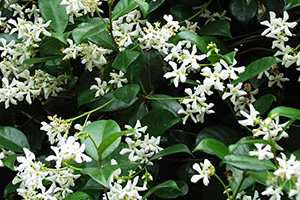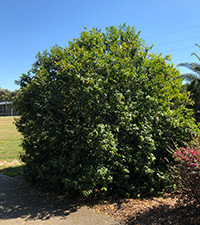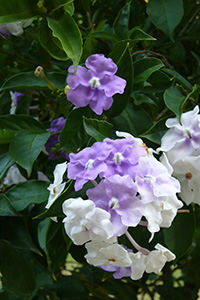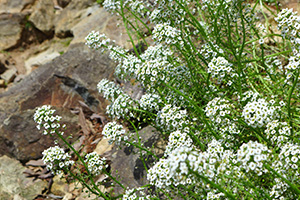Fragrance Gardens
Scent is one of the strongest human senses, and fragrant plants can add a new dimension to your landscape.

Fragrant plants take gardens to the next level, engaging the senses with various pleasant aromas.
Floral and herbal scents have been loved and distilled for centuries. They can be tied to memories and emotions, eliciting a cognitive response to familiar or comforting scents. Research demonstrates that humans can detect and distinguish between a wide range of smells, rivaling that of other mammals like rodents and dogs. Our strong sense of smell shapes how we experience our surroundings and connects us to the natural world.
With thoughtful planning and design, it’s not hard to create a fragrance garden with a diverse array of plants. You can foster a sensory experience with tangy, sweet, resinous or floral scents that rejuvenate or calm those who venture into the garden.
Florida is blessed with hundreds of divinely-scented plants — the trouble will be choosing which ones you want to plant! Below are some popular fragrant plants that grow well in Florida.
Gardenias

Gardenia (Gardenia jasminoides) flowers are extremely fragrant with a sweet scent sure to soothe the soul. The blossoms vary in color, from pale yellow with purple mottling to creamy white. Gardenia is an evergreen shrub with glossy, dark green foliage. Each cultivar varies in its height, ranging from 2-15 feet tall. This plant can be grown in USDA Hardiness Zones 7b to 11b in full sun or partial shade. Keep in mind that the grafted varieties are less cold hardy and may not be suitable for North Florida.
Tea Olive
Also called sweet osmanthus, tea olive (Osmanthus fragrans) has flowers that are sweet smelling with a light, pleasant fragrance. The blooms are tiny and creamy white, although some cultivars offer yellow or orange flowers. Adding to its appeal, this classic southern shrub blooms several times throughout the year and lives quite long. It can be grown in full sun or partial shade in North and Central Florida, but will also thrive in South Florida if you make sure to plant in partial shade.
Yesterday-Today-and-Tomorrow
Yesterday-today-and-tomorrow (Brunfelsia spp) will lure you in with its strong fragrance and color-changing flowers. Due to a pigment breakdown in the petals, these blooms change from lilac to lavender to white over the course of three days. The flowers appear in the warm months of the year and do best when provided with morning sun and afternoon shade. This interesting shrub can reach 8 to 10 feet tall, but can be kept shorter with some pruning. It does best in zones 9b to 11, but can be grown in North Florida if protected from freezes.
Star Jasmine

The intoxicating flowers of star jasmine (Trachelospermum jasminoides) have a strong, lovely fragrance, sometimes described as sweet or vanilla-like. The blooms tend to be more fragrant at night, so this evergreen can be used in a moon garden. Star jasmine blossoms in early spring and summer, with tiny white flowers that look like pinwheels or stars. It is a fast-growing, twining vine that can be grown on lamp posts, trellises or arbors, tying in decorative structures into your garden. It is grown widely in the Southeast and can be planted throughout Florida.
Sweet Alyssum
Sweet alyssum (Lobularia maritima) has petite flowers with a delicate, honey-like scent. They come in a variety of colors (white, purple, pink, yellow/peach) to suit your needs. These clustered blooms attract a host of bees, butterflies and other pollinating insects. The nectar-rich flowers feed these creatures throughout a long blooming season, from winter through spring. Its small mounding form (about 12 inches tall and wide) is suitable for garden beds, containers or hanging baskets, sure to add charm to any fragrance garden. Sweet alyssum thrives in hardiness zones 8 to 9.
Banana Shrub

Banana shrub (Magnolia figo) flowers resemble those of southern magnolia but much smaller in scale and smell like ripe bananas. This intriguing plant is both sweet and tough — it’s easy to take care of and incredibly fragrant. The cream-colored blooms, edged with crimson, appear in the spring. There is a cultivar called ‘Port Wine’ that has rose-colored to maroon flowers. Banana shrub has glossy, deep green leaves and can grow 10 to 15 feet tall if left unpruned. It can easily be maintained at a shorter stature and denser form with regular pruning. This flowering shrub prefers sun or light shade and can be grown in zones 7 through 10.
These fragrant plants (and more) are well-suited for Florida gardens. Our sense of smell can bring us closer to nature with the many aromas that are offered. For more recommendations, reach out to your local UF/IFAS Extension office.
Also on Gardening Solutions
More notably fragrant plants on Gardening Solutions
- Angel’s Trumpet
- Butterfly Bush
- Carolina Jessamine
- Horsemint
- Magnolias
- Plumeria
- Rosemary
- Roses
- Scented Geraniums
- Simpson’s Stopper
- Sweet Acacia
More from UF/IFAS
Resources
- Shepherd G. M. (2004). The human sense of smell: are we better than we think?. PLoS biology, 2(5), E146. https://doi.org/10.1371/journal.pbio.0020146



